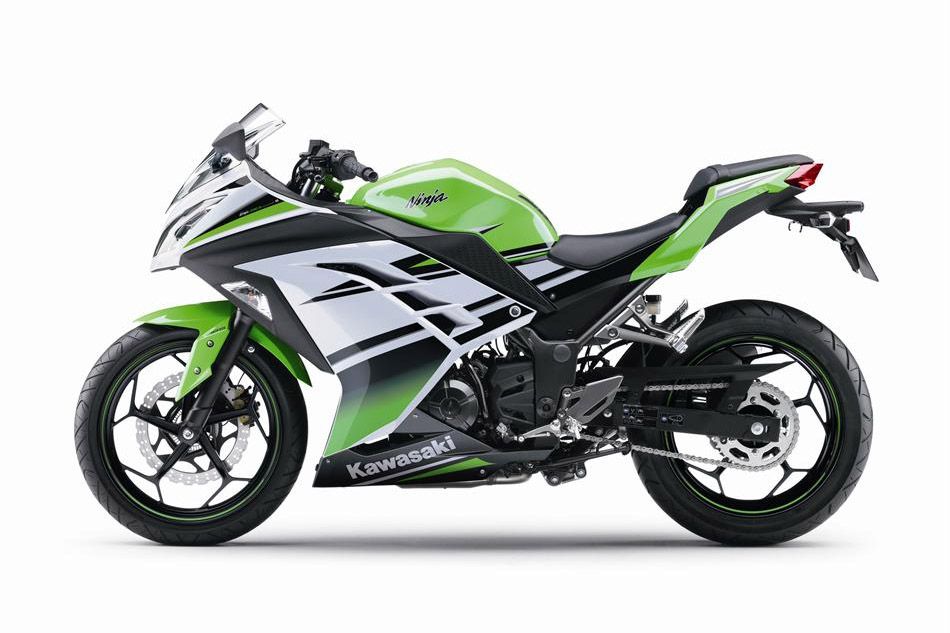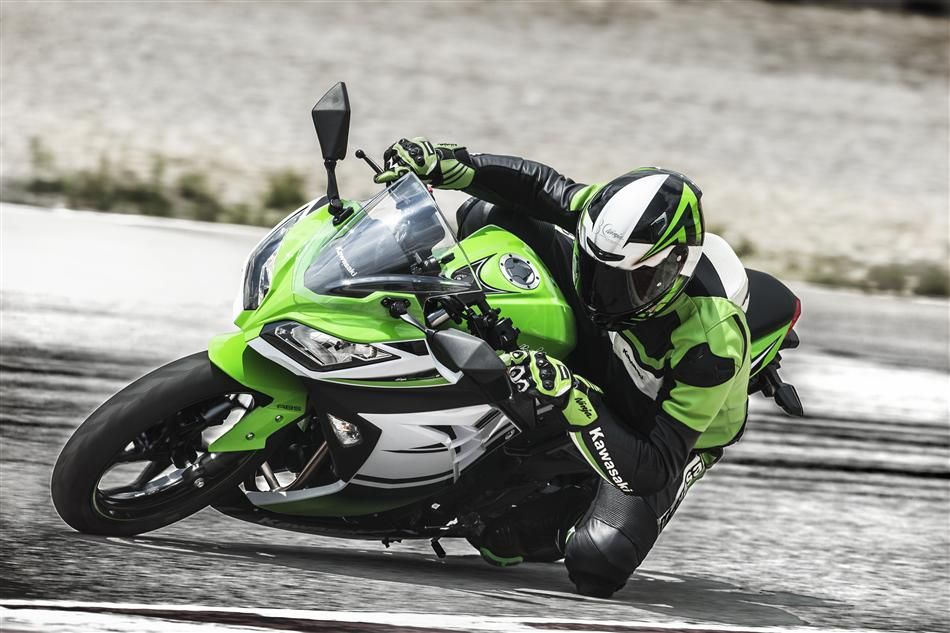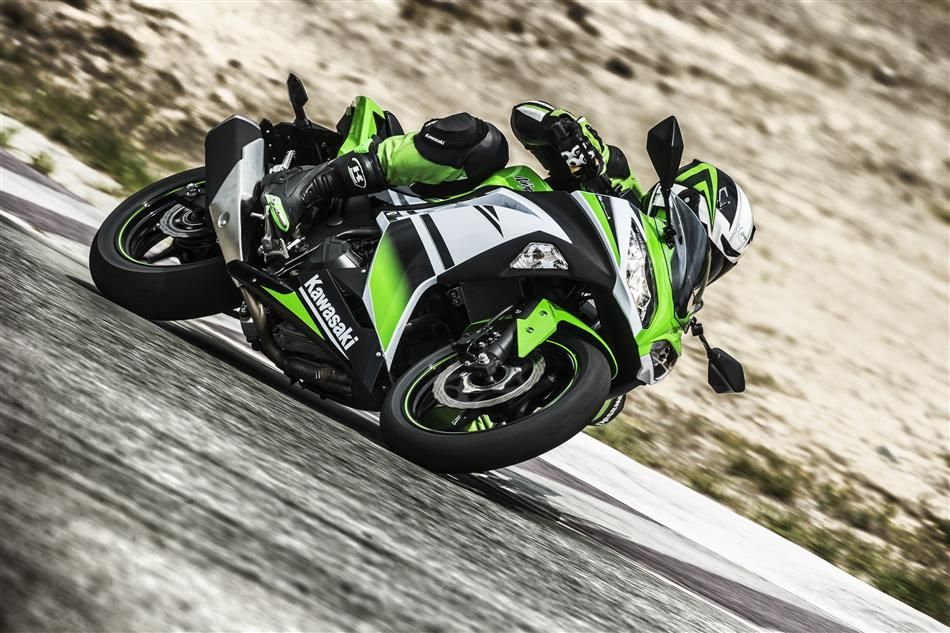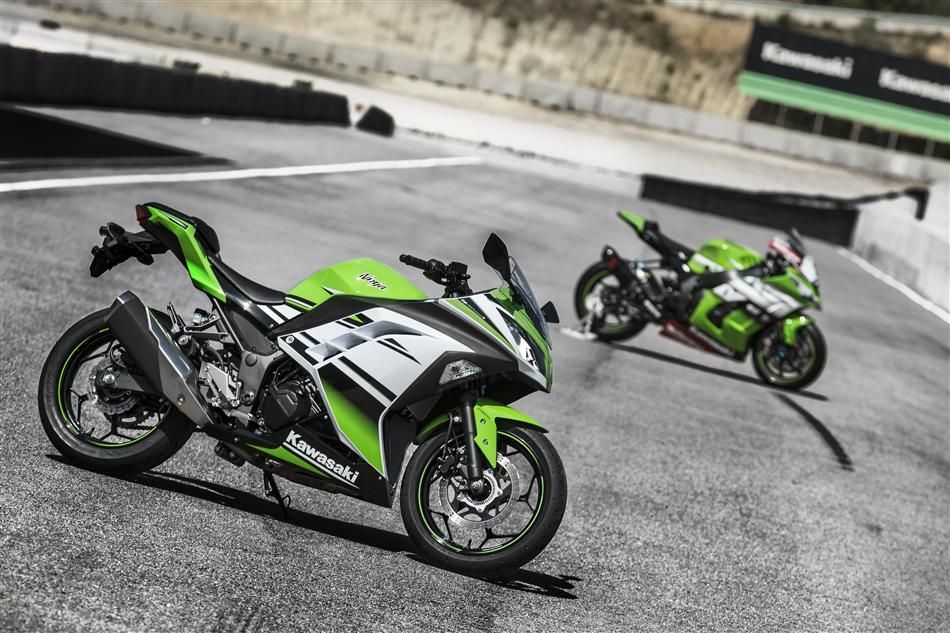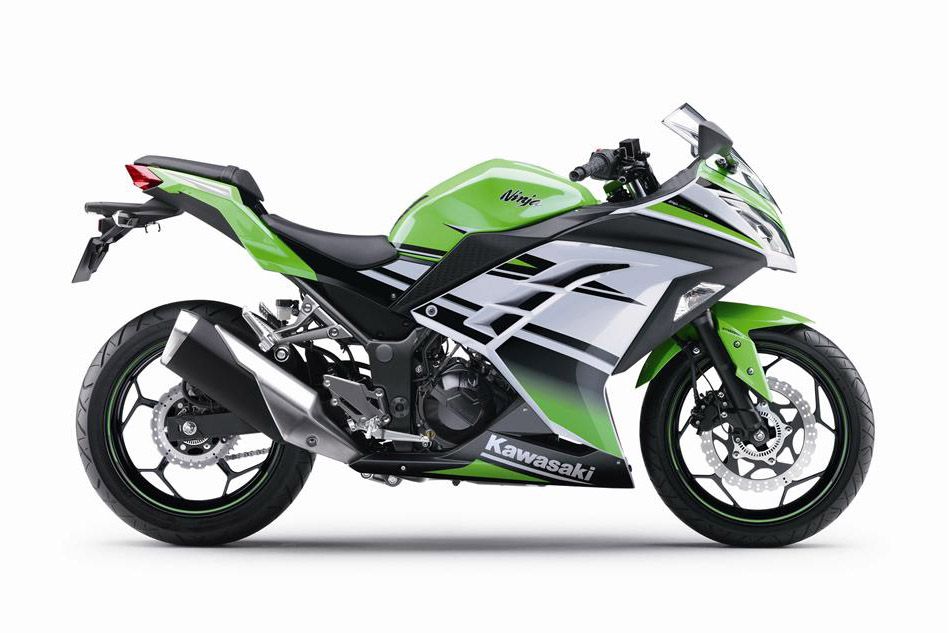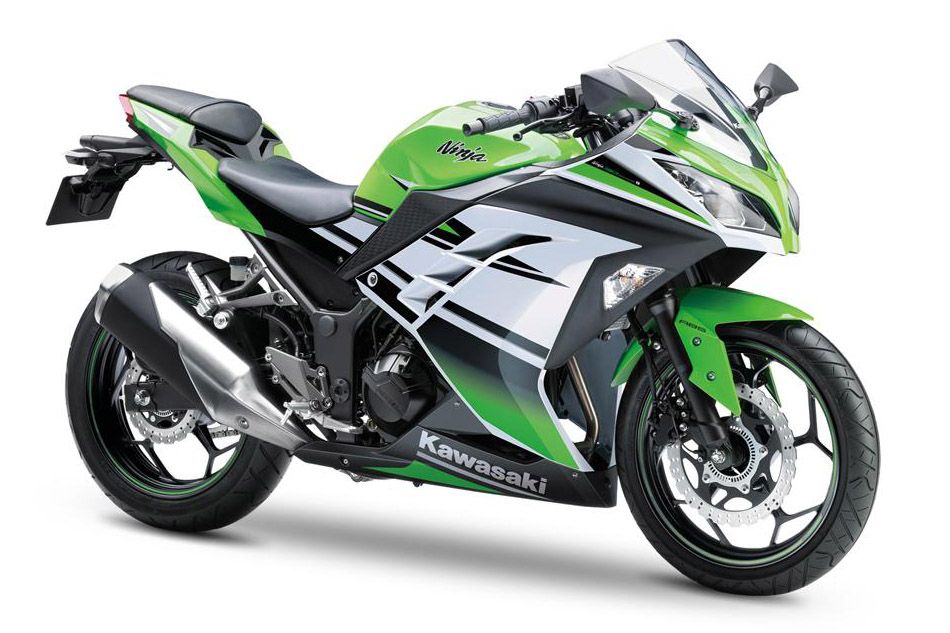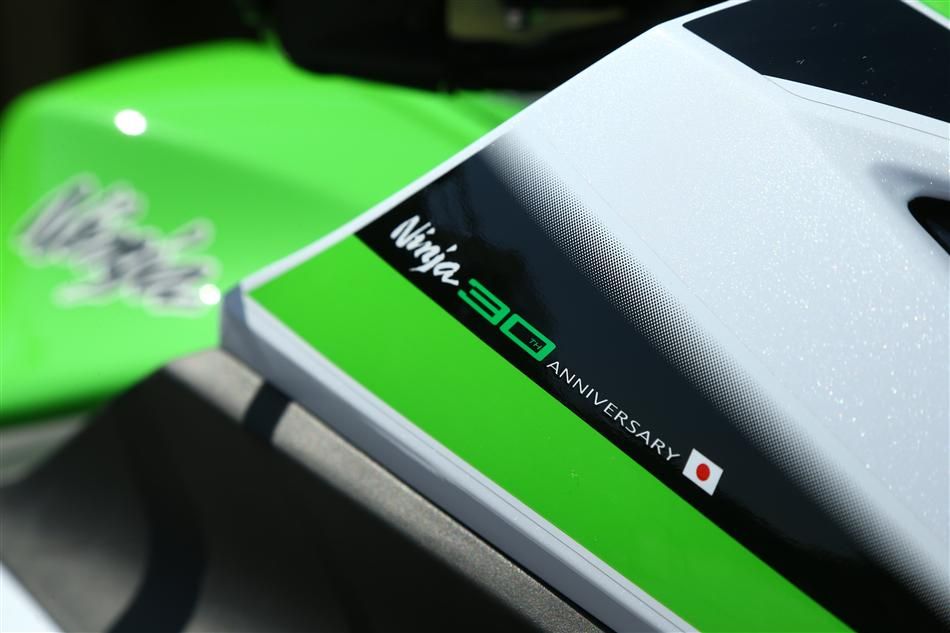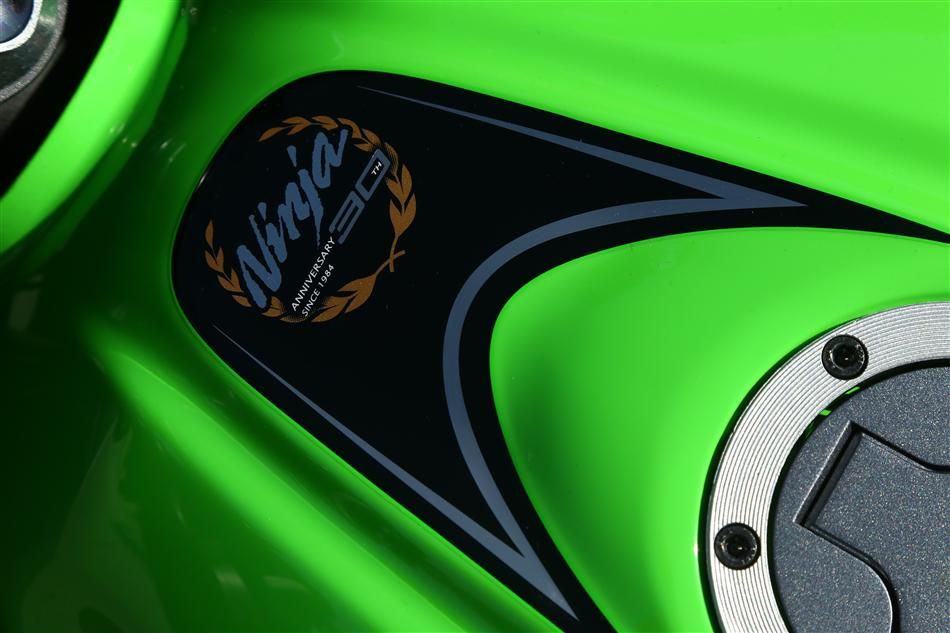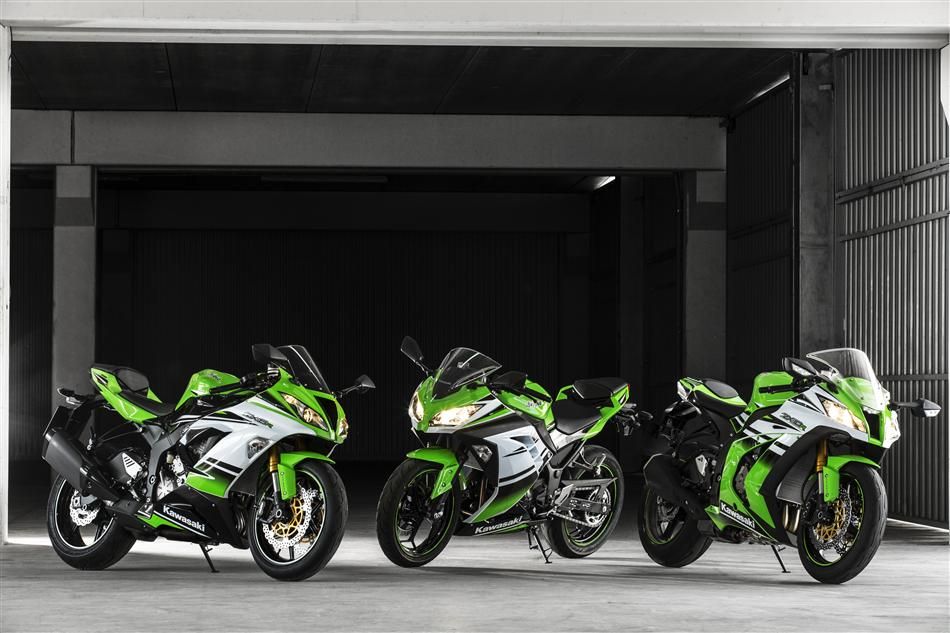2015 Kawasaki Ninja 300 30th Anniversary Edition
- Make: Array
- Model: 2015 Kawasaki Ninja 300 30th Anniversary Edition
- Engine/Motor: Liquid-cooled, 4-stroke Parallel Twin
- Horsepower: 21
- Torque: 20
- Transmission: 6-speed
- [do not use] Vehicle Model: Array
Overview
30 Years at the top
For thirty years we’ve created ultimate Supersport machines equally capable on road and track. Always our mission has been singular – to be at the top.
With World Endurance, WSBK and WSS Championship wins, the Ninja's define the Supersport category for racers and road riders alike. Now, to celebrate three decades of success, we announce three Anniversary Ninja models.
Ninja - top choice for thirty years.
Kawasaki Ninja 300 30th Anniversary Edition Video
2015 Kawasaki Ninja 300 30th Anniversary Edition Features and Benefits:
Modern Instrumentation
Sporty new instrument panel design contributes to the advanced-technology and high-quality image of the Ninja series. Multi-function LCD screen functions include: speedometer, clock, fuel gauge, dual trip meters, odometer and ECO Economical Riding indicator. White LED backlighting ensures clear meter visibility at night.
Radiator Fan Cover
The new fan cover located behind the radiator directs hot air down and away from the rider, significantly increasing comfort when stuck in heavy traffic. Redirecting the air also helps keep the tank, frame and other parts that contact the rider cooler, further increasing rider comfort.
Fuel injection
Fine-atomising injectors with a droplet size of only 60 µm contribute to combustion efficiency. New injector bodies are more compact.
296 cm³ Liquid-cooled 4-stroke Parallel Twin
The Parallel Twin engine produces smooth, torquey power at low and medium rpm and powerful acceleration at high rpm. Thanks to a longer stroke, the Ninja 300's new engine now displaces 296 cm3. Correspondingly the engine delivers noticeably stronger torque and power at all rpm. New pistons, cylinder, cylinder head and exhaust contribute to the improved performance.
New pistons
Lightweight new pistons with flatter crowns reduce reciprocating weight. The pistons feature a hard alumite coating for high durability.
2-1 exhaust with short-style silencer
Longer, larger-diameter header and centre pipes contribute to stronger performance at all rpm. New short-style silencer with complex cross-section enables the requisite volume while ensuring an ample lean angle. Large silencer guard protects passengers from heat and also contributes to noise reduction.
Wider rear tyre
Wider 140mm rear tyre matches the increased engine performance, contributes to an enhanced supersport image and contributes to the Ninja 300’s increased straight-line stability. New tyre compound offers good grip in both dry and wet conditions.
Petal disc brakes
Large-diameter 290mm front petal disc brake operated by a 2-pistons caliper delivers powerful braking and a natural feel at the lever. 220mm rear petal disc and 2-pistons caliper give dependable stopping power. Petal discs like those on the larger-displacement Ninja supersport models offer excellent heat dissipation.
Telescopic fork
To match the increased engine performance and more rigid frame, a new 37 mm fork with revised settings is fitted. Increased ride comfort in the city, and smooth, stable handling when sport riding is the result.
Aggressive styling
Like the other Ninjas in the series, the new Ninja 300 features a “mass-forward, minimalist-tail” design concept. Aggressive new dual headlamps, windscreen, wheels and numerous other styling elements inspired by Ninja flagship models give it a serious supersport look.
Sleeveless aluminium die-cast cylinder
Sleeveless, aluminium die-cast cylinder features plated bores, just like on our Ninja ZX-10R and ZX-6R supersport machines. The new cylinder features an open-deck design, offering excellent heat dissipation, and weighs 600g less than the previous sleeved cylinder.
Latest-spec ABS
For additional rider reassurance, an ABS model is also available. Its high-spec system designed by Nissin specially for motorcycles, delivers precise control and is extremely compact. A size of only 40% of previous Nissin ABS system makes it the world's smallest ABS unit.
Aluminium footpegs
Lightweight supersport-style aluminium footpegs give a more direct feel and good controllability when sport riding.
Rigid diamond frame
New diamond frame features redesigned main tubes, new high-tensile steel components, additional gusseting and rubber front engine mounts. Reduced vibration contributes to the Ninja 300's high-quality ride feel as well as increased rider comfort. Rigidity balance fine-tuned on the circuit ensures the high level of chassis stability necessary for sport riding.
Uni track rear suspension
Kawasaki’s original linkage-equipped Uni-Trak rear suspension delivers a smooth ride and stable handling over a wide range of speeds and road conditions.
Economical Riding Indicator
Using high-precision electronic control for engine management, Kawasaki models can achieve a high level of fuel efficiency. However, fuel consumption is greatly affected by throttle use, gear selection, and other elements under the rider's control. The Economical Riding Indicator is a function that indicates when current riding conditions are consuming a low amount of fuel. The system continuously monitors fuel consumption, regardless of vehicle speed, engine speed, throttle position and other riding conditions. When fuel consumption is low for a given speed (i.e. fuel efficiency is high), an "ECO" mark appears on the instrument panel's LCD screen. By riding so that the "ECO" mark remains on, fuel consumption can be reduced. While effective vehicle speed and engine speed may vary by model, paying attention to conditions that cause the "ECO" mark to appear can help riders improve their fuel efficiency – a handy way to increase cruising range. Further, keeping fuel consumption low also helps minimise negative impact on the environment.
Assist & Slipper Clutch
Based on feedback from racing activities, the Assist & Slipper Clutch uses two types of cams (an assist cam and a slipper cam) to either drive the clutch hub and operating plate together or apart. Under normal operation, the assist cam functions as a self-servo mechanism, pulling the clutch hub and operating plate together to compress the clutch plates. This allows the total clutch spring load to be reduced, resulting in a lighter clutch lever feel when operating the clutch. When excessive engine braking occurs – as a result of quick downshifts (or an accidental downshift) – the slipper cam comes into play, forcing the clutch hub and operating plate apart. This relieves pressure on the clutch plates to reduce back-torque and help prevent the rear tyre from hopping and skidding.
ABS
Sudden over-application of the brakes, or braking on low-grip surfaces (surfaces with a low coefficient of friction) such as wet asphalt or manhole covers may cause a motorcycle's wheel(s) to lock up and slip. ABS was developed to prevent such incidents. Kawasaki ABS systems are controlled by high precision and highly reliable programming formulated based on thorough testing of numerous riding situations. By ensuring stable braking performance, they offer rider reassurance that contributes to greater riding enjoyment. And to meet the special requirements of certain riders, specialised ABS systems are also available. For example, KIBS (Kawasaki Intelligent anti-lock Brake System) is a high-precision brake system designed specifically for supersport models, enabling sport riding to be enjoyed by a wider range of riders. And by linking the front and rear brakes, K-ACT (Kawasaki Advanced Coactive-braking Technology) ABS provides the confidence to enjoy touring on heavyweight models. Kawasaki is continually working on the development of other advanced ABS systems.
Dual Throttle Valves
Late-model sport bikes often use large-bore throttle bodies to generate high levels of power. However, with large diameter throttles, when a rider suddenly opens the throttle, the unrestricted torque response is anything but gentle and often more than the rider can handle. Dual throttle valve technology was designed to tame engine response while contributing to performance. On fuel-injected models, throttle bodies generally have only one throttle valve per cylinder. On models with dual throttle valves, there are two throttle valves per cylinder: in addition to the main valves, which are physically linked to the throttle grip and controlled by the rider, a second set of valves, opened and closed by the ECU, precisely regulates intake airflow to ensure a natural, linear response. With the air passing through the throttle bodies becoming smoother, combustion efficiency in improved and power is increased. Like other Kawasaki engine management technology, Dual Throttle Valves were designed with the philosophy of "following the rider's intention, while providing natural-feeling support." They are featured on many Kawasaki models.
Specifications
|
Engine type |
Liquid-cooled, 4-stroke Parallel Twin |
|
Displacement |
296 cm³ |
|
Bore x stroke |
62.0 x 49.0 mm |
|
Compression ratio |
10.6:1 |
|
Valve/Induction system |
DOHC, 8 valves |
|
Fuel system |
Fuel injection: ø32 mm x 2 with dual throttle valves |
|
Ignition |
Digital |
|
Starting |
Electric |
|
Lubrication |
Forced lubrication, wet sump |
|
Maximum power |
29.0 kW 39 PS / 11,000 rpm |
|
Maximum torque |
27.0 N•m 2.8 kgf•m / 10,000 rpm |
|
Transmission |
6-speed, return |
|
Final Drive |
Sealed chain |
|
Primary reduction ratio |
3.087 (71/23) |
|
Gear ratios: 1st |
2.714 (38/14) |
|
Gear ratios: 2nd |
1.789 (34/19) |
|
Gear ratios: 3rd |
1.409 (31/22) |
|
Gear ratios: 4th |
1.160 (29/25) |
|
Gear ratios: 5th |
1.000 (27/27) |
|
Gear ratios: 6th |
0.857 (24/28) |
|
Final reduction ratio |
3.000 (42/14) |
|
Clutch |
Wet multi-disc, manual |
|
Frame type |
Tubular diamond, steel |
|
Rake/Trail |
27° / 93 mm |
|
Wheel travel, front |
120 mm |
|
Wheel travel, rear |
132 mm |
|
Tyre, front |
110/70-17 M/C 54S |
|
Tyre, rear |
140/70-17 M/C 66S |
|
Steering angle, left / right |
35° / 35° |
|
Brakes, front |
Single 290 mm petal disc. Caliper: Single balanced actuation dual-piston |
|
Brakes, rear |
Single 220 mm petal disc. Caliper: Dual-piston |
|
Suspension, front |
37 mm telescopic fork |
|
Suspension, rear |
Bottom-Link Uni-Trak with gas-charged shock and 5-way adjustable preload |
|
Dimensions (L x W x H) |
2,015 mm x 715 mm x 1,110 mm |
|
Wheelbase |
1,405 mm |
|
Ground Clearance |
140 mm |
|
Fuel capacity |
17 litres |
|
Seat height |
785 mm |
|
Curb Mass |
172 kg / 174 kg (ABS) |
Quotes
“The iconic Kawasaki Ninja range of motorcycles completes 30 years in production and to commemorate this achievement, Kawasaki has unveiled a 30th Anniversary Edition 2015 Ninja 300. The new model is the fourth motorcycle to be launched under the “30th Anniversary Edition” moniker after the Kawasaki Ninja ZX-14R, ZX-10R and ZX-6R. The Kawasaki Ninja 300 30th anniversary edition will be only offered in a single shade of the iconic lime green. To distinguish the anniversary edition from the stock bike it will feature a sporty graphics in black and white. Also it will sport a 30th Anniversary emblem on the fuel tank and on the fairing.” ----- ZigWheels“To celebrate 30 years of the Ninja, Kawasaki have released three Special Edition Anniversary Models - Ninja 300, ZX-6R (636) and ZX-10R. Each model features special 30th Anniversary paint and decal schemes which reflect the current ZX-10R World Superbike. Powered by a 296cc parallel twin engine, the new Ninja 300 brings more power, more torque and improved power delivery over the already brilliant Ninja 250. With Fuel Injection and Dual Throttle Valves power delivery is smoother and more efficient, giving you responsive torque at low and medium rpm to a hard-hitting acceleration rush at higher rpm.” ----- Motorad


